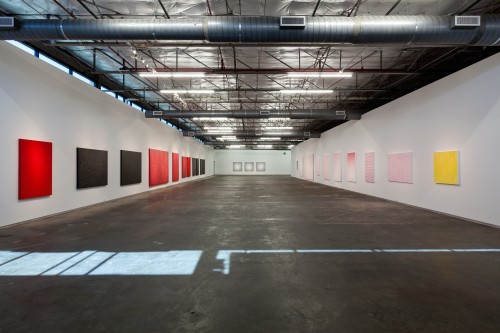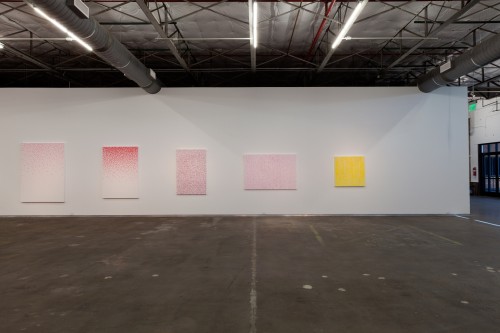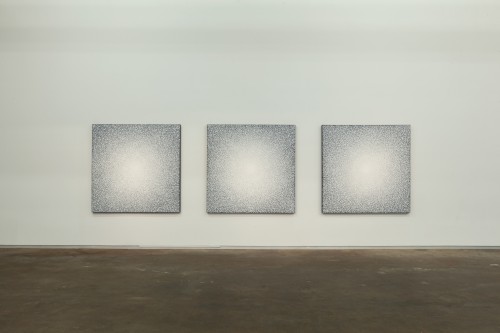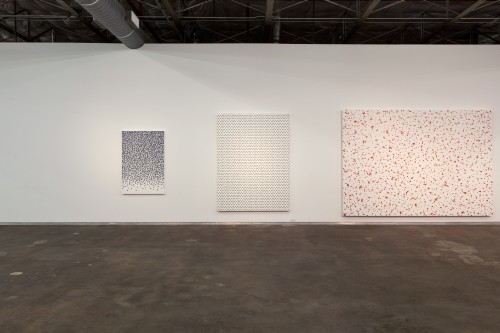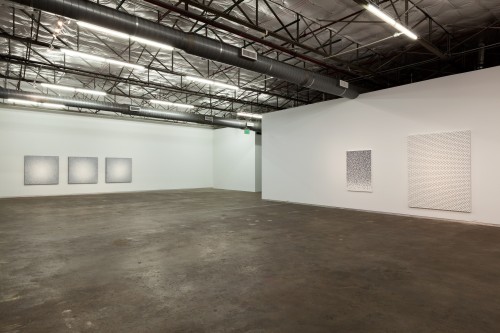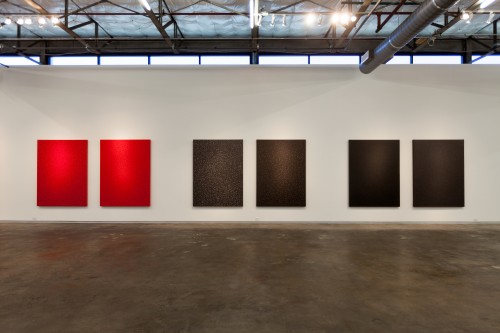

Piotr Uklański
The Dallas Contemporary, Dallas
21 September – 21 December 2014
by LILLY WEI
Piotr Uklański (b1968), a native of Warsaw who spends much of his time in New York –or wherever his projects require him to be – is showing two dozen of his paintings, designated as “blood,” or more factually, “ink drop” paintings, at the Dallas Contemporary art museum, the largest showing of them to date. It is an ongoing series of hand-painted abstractions that he began in 2007 and is relatively quiet in contrast to the high-pitched works usually associated with him, although it has its own compelling thrum. He studied painting at the Academy of Fine Arts in Warsaw, then switched to photography when he went to the Cooper Union in New York.
Uklański, a visual polyglot, has worked in almost every medium – painting, sculpture, photography, collage, installation, performance and film – and his references are as far-ranging and unexpected as the materials he uses. His reputation is international and he has shown in many of the world’s eminent institutions and biennales, among them the Museum of Modern Art and the Guggenheim Museum in New York with two shows at the Metropolitan Museum of Art scheduled for 2015, the Pompidou Centre in Paris, the Ludwig Museum in Cologne, Kunsthalle Basel, Palazzo Grassi in Venice and the Venice and São Paulo biennales. His ventures have often been a kind of lightning rod, his subjects at times controversial, at times merely mischievous, his aesthetics and attitudes idiosyncratic and fluid. Perhaps the most widely reported contretemps involved his photographic series, Untitled (The Nazis), vandalised by Daniel Olbrychski, a famous Polish actor, while the work was on view in Zachęta, the National Gallery of Art in Warsaw in 2000. Uklański premiered his first feature-length film, Summer Love, billed as the first Polish western,in 2006. He is also deeply interested in historical styles, such as art informel, colour field, abstract expressionism, Gutai and pop, paying tribute to them while treating them with a certain scepticism as well as a certain disconcerting sincerity, as is evident in this show.
These so-called blood paintings, from 2008-14, are all Untitled followed by titles in parentheses that are more ghoulish than the paintings appear: Untitled (Bloody Soul); Untitled (Witch Blood); Untitled (Black Plague); Untitled (Warsaw Uprising ’44 – Wola). Inferences are rife, including his interest in spaghetti westerns and Dario Argento’s blood-drenched thrillers, not to mention Hermann Nitsch, the controversial Viennese actionist. On canvases and works on board, they are executed in watercolour or ink and gesso, using Japanese sumi inks or shellac inks, the scale varying. Made by hand, the ink dropped on to the surface, layer after layer, it is a process that Uklański has described as slow and laborious. The works also vary in composition, some in grid-like patterns while others are more all-over, suggesting, in the red paintings, at least, splattered blood. However, they are also meditative, tracing time across their surfaces in droplets like the tap of heartbeats, a tracing that inevitably leads to death. “I think of death all the time,” he says, part of his Polish heritage, no doubt, which glorifies both blood and mortality.
The following is excerpted from an edited conversation between Uklański and Lilly Wei that took place in Dallas.
Lilly Wei: What are the colours of the Polish flag? I noticed that the paintings in this show are red, white, yellow, black and grey.
Piotr Uklański: White and red.
LW: With a bit of yellow or gold if it is the flag that includes the Polish coat of arms with its crowned white eagle.
PU: Funny that you mention it. I did a show in 2008 in New York and it took on national identity as a way to specifically reflect on art and culture. The paintings were resin and ink, the first ink paintings that referenced the idea of the blood of the martyrs. Polish identity is very much based on sacrifice, on spilling your blood to preserve the nation. I made those paintings to commemorate the Warsaw Uprisings. I come from Warsaw and was raised on the romantic cult of the Uprising, even though it was a failure.
LW: But romanticism is about romanticising failure.
PU: Yes, exactly. It’s crazy. On 1st August, we have one of the sexiest, most beautifully executed events of the year, but it celebrates the destruction of most of the city and the death of 200,000 inhabitants of Warsaw in 1944. On the one hand, it’s great there is the memory of it, but on the other, it has become way too pop for most people’s taste. My show in 2008 referenced cliched ideas of identity, and the paintings reflected the Warsaw Uprising in their titles. I became interested in how the language of popular culture functioned on a wall, on a screen, in a magazine. I figured that the splash of red paint or ink is part of that vocabulary. But as I continued to make these works, maybe because they are very time consuming and most of my other work is not really made that way, not by meticulously adding drop after drop of ink, layer after layer, day after day, I started to think about them in a different way. I abandoned the specific Polish reference, although I played a lot with the idea of blood and its more common associations. Then I came across a nice quote from Roman Opalka [French-born Polish painter, 1931-2011] about time. The project evolved naturally, and became much more about painting in which the last works were the three square panels, the ones with no colour.
LW: Will you make more?
PU: It’s hard to do them – I can’t go and make 10 because its takes three months to make one. And generally, I can’t plan it out – the process slows me down.
LW: And you think quickly?
PU: Yes, but maybe this is something I miss. Maybe slowing down, maybe not being on the phone while I’m working, maybe it’s meditative.
LW: You work with so many materials, media, and subjects. What ties them together?
PU: I wonder – maybe its disbelief? At heart, I’m a pessimist. Maybe art is not such a great notion. Rothko thought it had the power to replace religious experience, and it might be able to do that and at the same time, it might do none of that, it might be a fable.
LW: But it’s an important fable, don’t you think?
PU: Of course. I’ve dedicated my life to it, so I should believe it.
LW: What are some of the issues that engross you?
PU: I’m a Polish artist and I have so much legacy. But I live in New York and have made it my home, so the idea of being a Polish artist has become a little like identity politics. Let’s say this: my overall understanding of my practice is based on where I come from, but the tools I use aren’t. But I wonder how much that influences me? In the end, do I believe that these categories really exist? Isn’t all of this a human pursuit, a quest?
LW: Is art, then, something that begins with a capital A?
PU: For me, as an artist, it’s work. I go every morning to the studio. And I get frustrated when I can’t get what I aim for. I’m like a carpenter – I’m not into capital A.
LW: It’s old news but would you talk a little about the response to the Nazi series you showed at Zachęta in 2000 when Olbrychski, who was pictured in the series, slashed several of the photographs with a sabre? Would it happen today?
PU: Well, the debate has changed since then. Right-wing politicians used it to make themselves heard and there was a context that permitted a well-known actor, as in my case, to come into the national gallery and destroy my work and not be responsible for it financially or civically. But the context is a little different now. The political debate is much more mature.
LW: The response to your retrospective there around two years ago was entirely different?
PH: Yes.
LW: And what did you have in mind with this show?
PU: I was struggling for a while about what to do, but when I came to Dallas last April, I was able to see a few of the collections here, the Rachofsky collection, the Faulconers, the Warehouse. I was surprised that there was interest in postwar art that was non-American, such as art informel and Gutai. I had a prior interest in postwar European art because the belief that art can help deal with the trauma of war, the belief that it can do so much, fascinated me. And I came to Dallas. For me, it’s a very American context and yet there is a very specific interest in something so disconnected. Dallas didn’t experience either war directly; it happened across the ocean. I wanted to reference that in some way and thought of this project in my studio. It was a coincidence, but I liked the idea of being specific to my experience, that it wasn’t made for this but fitted into this context.
LW: How strongly did the second world war affect you, since you were born more than 20 years later? Although when I first visited Poland, in 2000, Warsaw still looked bleak, if not ravaged.
PU: Yes, exactly. As a child, I walked to school past buildings with walls still filled with holes from bullets and mortars. They had not been patched since they were privately owned and people didn’t have the money. When you’re seven, you’re used to it, you think it’s normal. Later, you put it together. Our sitcom was about four men in a tank and a dog. That was a series that we rewatched year after year. We didn’t have the Little House on the Prairie. It affects you. My grandfather was a soldier. He was captured, put in a German camp, but he didn’t want to talk about it. I saw the evidence, I spoke to someone who went through it. But my grandfather died when I was 20, when I had just begun to be interested in his experiences, and my parents couldn’t really provide any details since they were born at the end of the war. I grew up with it, but it is more of a storytelling experience. It was removed but also present, but present as a legacy.
LW: Is your subject death?
PU: This is surely not a popular subject, but I think it’s important to make a certain distinction. I don’t believe that talking about death necessarily helps us to understand the idea of death better, or to come to terms with it. I’m interested because it’s not a subject that is talked about, like religion; they are both neglected subjects. It’s a challenge because it’s hard to find a way to present them that is appealing to the contemporary viewer. They don’t want to hear about it.
LW: Then what kind of art should an artist be making today?
PU: Artists should be doing what they are doing. They should amalgamate all the positions and reflect their time. Do you think they should be doing something else?
LW: No. I like the multiplicity of positions that are offered. I like the contradictions. Can anyone say anything that can’t be contradicted?
PU: Yes exactly, but that might be the beauty of it. So it’s not a fair question to ask what art should be. Because there’s no such thing as “should be”. I’m fascinated that people think art “should be” and I wonder if it “should be.” The understanding of art fluctuates. There’s a moment when art should do a lot of things – be combative, break boundaries, bring discoveries – and then there is the moment when you believe it can’t do any of that, that it’s a fable.
LW: Would you talk about your projects for the Metropolitan Museum for next year?
PU: I’m working on a solo exhibition for March at the Met and also I will be curating a selection from its collection. I could go so many ways, but obviously I picked Eros and Thanatos so I looked at the collection with this in mind. I was not interested in skulls and the Kama Sutra. I was looking for much more complex perversions, something very atypical. It’s an interesting thread to follow through so many centuries, with astounding results even if the quest is ridiculous.
LW: You’ve been called a provocateur. Do you agree?
PU: No, I don’t think I am. I don’t set out to provoke. But the artist puts the work out there and it has its own life, so viewers come and fill it in with what they know. Everybody knows Nazis in Germany. I had a drink with a German artist who said if he had made this work they would have killed him but because I am Polish, I could. My point is more this. In that context, because Germans have such a long history of analysing the second world war, the reaction to my series was very measured, very civil. But in Poland, it wasn’t. So it depends on context and the debate of the moment, and both bring very different reactions. At the Jewish Museum in New York, it was also judged differently. It’s context and what the viewer brings to the work that causes the scandal, the strong reaction, more than the work itself.
LW: So tell me again what the thread in your work is?
PU: Pessimism. (He smiles.)
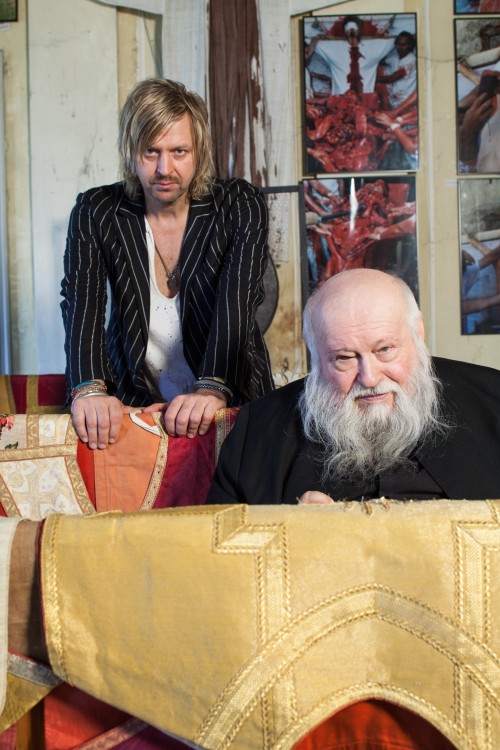
, 2013_Courtesy of Dallas Contemporary.jpg)
, 2012_Courtesy of Dallas Contemporary.jpg)
, 2013_Courtesy of Dallas Contemporary.jpg)
, 2014_Courtesy of Dallas Contemporary.jpg)
, 2012_Courtesy of Dallas Contemporary.jpg)
, 2011_Courtesy of Dallas Contemporary.jpg)
, 2014_Courtesy of Dallas Contemporary.jpg)
-2008.jpg)
